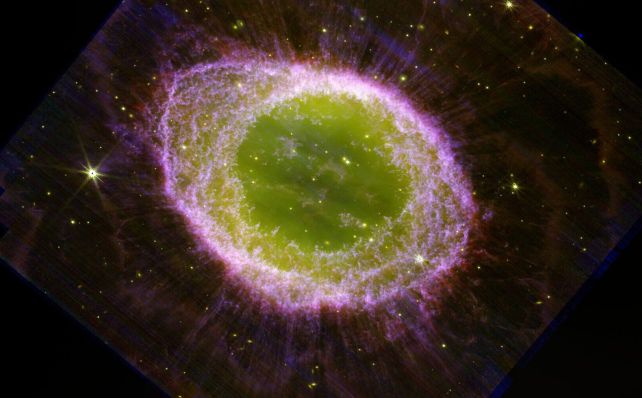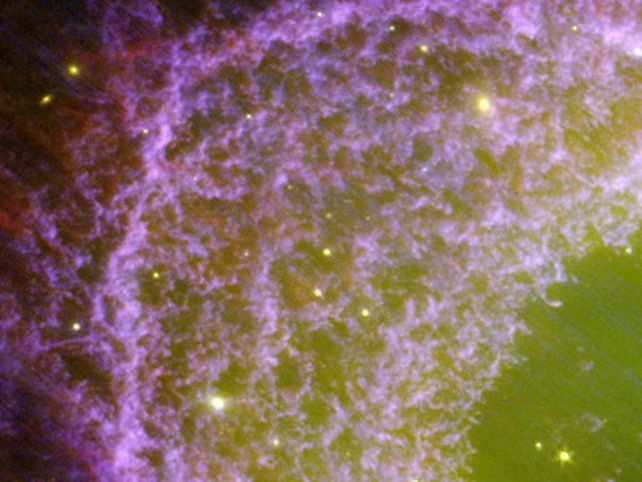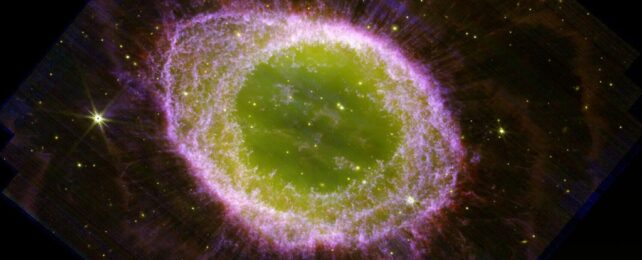A star that is in its death throes gleams like gold in new images from the James Webb Space Telescope.
It's called Messier 57, AKA the Ring Nebula, a glowing circle of gas in the constellation of Lyra, some 2,750 light-years from Earth, produced by the ejection of material by a lower-mass star as it dies. The spectacular resolution of the JWST will reveal the intricate knots and patterns in this material, to help better understand what happens when stars like the Sun reach the end of their lives.
"We are witnessing the final chapters of a star's life, a preview of the Sun's distant future so to speak, and JWST's observations have opened a new window into understanding these awe-inspiring cosmic events," explains astrophysicist Mike Barlow of University College London in the UK, and co-leader of the international JWST Ring Nebula Project.
"We can use the Ring Nebula as our laboratory to study how planetary nebulae form and evolve."

A planetary nebula has nothing to do with planets; they're named that way because 18th century astronomers thought that their round shape was planet-like. They are actually much bigger and more dynamic: the clouds of material surrounding stars smaller than eight solar masses that are at the end of their lives.
When they run out of material to fuse in their cores, these stars destabilize, and eject all their outer material. The stellar core, no longer supported by the outward pressure of fusion, collapses under gravity into a white dwarf. This is the eventual fate of the Sun and most of the stars in the Milky Way.

The Ring Nebula was created by a star that reached the end of fusion some time in the last 2,000 years from our perspective. At its center is a white dwarf around 60 percent of the mass of the Sun; the material around this star is expanding outwards into space in a sphere that to us looks like a ring filled with glowing material.
The outer shell of the nebula is thick and dusty, and carved out into intricate structures where it punches into and interacts with the interstellar medium. Studying these structures can help scientists understand the physical processes involved in the shape and expansion of a planetary nebula; and the JWST has provided breathtaking detail.
"The James Webb Space Telescope has provided us with an extraordinary view of the Ring Nebula that we've never seen before," Barlow says. "The high-resolution images not only showcase the intricate details of the nebula's expanding shell but also reveal the inner region around the central white dwarf in exquisite clarity."

The data is still undergoing analysis, but already the observations are revealing an unexpected complexity that the team is excited to delve into. In addition to the incredible detail seen in the structure of the shell, the observations also have delivered a wealth of data on the composition of the nebula, including large, carbon-based molecules whose origin is currently unclear.
"These images hold more than just aesthetic appeal; they provide a wealth of scientific insights into the processes of stellar evolution," says astrophysicist Nick Cox of ACRI-ST in France, and co-leader on the JWST Ring Nebula Project.
"By studying the Ring Nebula with JWST, we hope to gain a deeper understanding of the life cycles of stars and the elements they release into the cosmos."
